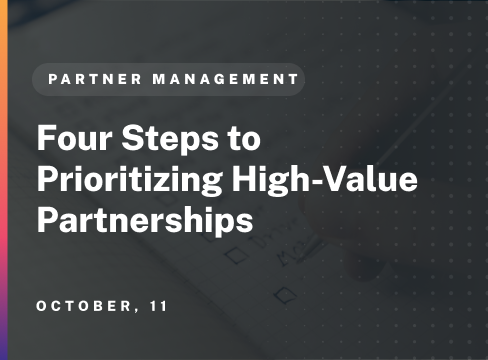This blog is part of the SCOPE: Partner Qualification Blog Series. All series content is powered by insights from our community experts.
The SCOPE: Partner Qualification course is an exclusive, member-only program designed to help strengthen your partner ecosystem using the SCOPE framework: Scale, Champion, Objectives, Proposition, and Executive Stakeholder. In this course, you’ll learn how to assess partner potential, align strategic goals, and accelerate revenue growth.

Ready to build a smarter, more impactful partner ecosystem? Check out the SCOPE: Partner Qualification course today and unlock the full potential of your strategic alliances!
Choosing which partnerships to prioritize within your partner ecosystem can be overwhelming. You need to focus on the ones that will light up your business while ensuring you’re not burnt out. In this third installment of our blog series, we’ll explore how to effectively prioritize high value partnerships for maximum impact.
By the end, you’ll have a clear roadmap for identifying and nurturing the partnerships that propel your business forward.
Step 1: Use Data-Driven Frameworks
High-value partnerships don’t happen because of gut feelings. Using data-driven frameworks helps you assess partners objectively. This ties into the Scale component of the SCOPE framework, where you evaluate a partner’s growth potential and ability to contribute to long-term success.
Implementing data-driven frameworks ensures all partners are assessed using the same criteria. It also makes it easier for your team and leadership to understand why certain partners are prioritized based on actual information.
Chris Lavoie’s own PARTNER Framework is designed to make it “dead easy for partner managers to record key/relevant qualifying info.” The acronym stands for:
- Potential for Growth
- Alignment with Strategic Goals
- Relationship Strength
- Track Record & Reliability
- Network & Influence
- Execution Capability
- Revenue Potential
Using this framework within your CRM system – like HubSpot – helps you capture essential data points from your partner ecosystem.
Bertus Van Overmeiren also uses a company tool called Partner Heartbeat to “constantly recalibrate our partnerships.” This dashboard provides a real-time overview of each partnership’s momentum.
“If the traffic lights stay red for a long time, it indicates that we have to deprioritze the partner or we need to step up our game.” – Bertus Van Overmeiren
Here are the elements included in the Partner Heartbeat tool:
- Next steps planned
- In-person meetings conducted
- Leadership connections established
- Active joint opportunities
- Agreed-upon services
- Defined joint marketing initiatives
- Meeting governance (QBRs. development calls)
- Staff training status
Keep a close eye on these indicators to quickly identify which partnerships in your partner ecosystem are thriving and which may need attention or even reprioritization.
Step 2: Implement Scoring Systems
Once you’ve gathered data using frameworks, it’s time to quantify your findings.
Assigning scores to potential partners helps you prioritize them based on measurable criteria, ensuring that your resources are focused on where they’ll have the most impact.
This directly aligns with the Champion and Objectives components of the SCOPE framework.
For example:
- Champion: Does the partner have an internal advocate, like a Champion, to push initiatives forward? Strong Champions increase the likelihood of joint success.
- Objectives: Does the partner’s goals align with your strategic objectives? Alignment in this area ensures you’re working toward shared outcomes.
“We look at several quantitative and qualitative metrics, rated High-Medium-Low, with each metric giving a certain weighting as a %. We then calculate the potential of the partner with a score of 1 to 5. Partners scoring above 4.35 are High Priority, 4 to 4.35 are Medium Priority, and anything below 4 is Low Priority.” – Jakob Stubbe
Here are the metrics they consider:
- Addressable Volume: The total payment volume flowing through a partner’s platform.
- Share of Wallet: The percentage of that volume you already process.
- Willingness to Work Together: Presence of a champion, executive sponsorship, and engaged sales and product teams.
- Account Mapping: Number of accounts in your target list overlapping with the partner’s customer base.
- Industry Coverage: The size of the partner’s customer base in your focus industries.
- Cost vs. Earnings: The budget, time, and resources needed versus potential revenue.
- Partner Growth: The rate at which the partner is growing its market share.
- Innovation: The innovativeness of the partner’s solution.
By quantifying these factors, you can create a composite score that objectively ranks your partners in your partner ecosystem.
Sonia Marie Goff also emphasizes the importance of an Ideal Partner Profile (IPP) and automated scoring:
“To truly be able to qualify partners, reprioritize partners, articulate joint-value propositions, etc., we’ve found it helpful to revisit and clarify our IPP definition. The big ‘win’ coming out of this has been the creation of an automated scorecard that our Partner Acquisition teams use to qualify partners.” – Sonia Marie Goff
Their scoring system evaluates partners based on four categories:
- Company Profile: Size, revenue, market presence.
- Customer Profile: Alignment with your Ideal Customer Profile (ICP).
- Tech Stack Expertise: Familiarity and expertise with relevant technologies.
- Strategic Alignment: Cultural fit and shared long-term goals.
Each category is assigned a score, providing a clear picture of how well a partner aligns with your company’s objectives.
Step 3: Align on Strategic Goals
While data and scoring systems are essential, aligning on strategic goals is the glue that holds a high-value partner ecosystem together.
This step is closely tied to the Objectives and Proposition components of the SCOPE framework. Without shared objectives and a strong value proposition, even the most promising collaborations can lose steam.
“We quickly established a top tier of 10 partners, along with a cohort of 20 ‘potential’ top-tier candidates. The next phase was to execute a full co-marketing and co-selling motion with each of these 10 partners, to 1. Prove the model and 2. Create scalable playbooks for the next cohort.” – Jason Lawson
By focusing on partners whose objectives aligned with his company’s, Jason concentrated resources effectively and developed scalable strategies for future partnerships.
Additionally, Proposition is about crafting a joint value proposition that resonates both internally and externally. By regularly reviewing your partner ecosystem and ensuring that shared value propositions stay aligned with evolving business goals, you maintain a strong foundation for long-term success.
Similarly, Justin Graci highlights the need to evolve partnerships as the goals of a partner ecosystem change:
“As time went on and our platform expanded across CRM, Sales, Service/Help Desk, Operations, and Commerce, some partners evolved with us, but we still needed to attract and grow more partners who had expertise in the CRM Implementation, Integration, and Help Desk space. This led to a re-branding of our program from the Agency Partner Program to the Solutions Partner Program, making it more inclusive of all partner types, not just agencies.” – Justin Graci
HubSpot recognized that their existing partnerships were heavily skewed toward marketing agencies, which didn’t align with their expanded product offerings. By realigning their strategic goals and rebranding their partner program, they could attract partners better suited to their new direction.
Here are some action steps when aligning on strategic goals:
- Reevaluate Your Partner Ecosystem: Regularly assess whether your current partners still align with your company’s evolving objectives.
- Open Communication: Engage in honest dialogues about long-term partner ecosystem goals and how you can support each other’s strategies.
- Mutual Business Planning: Develop joint business plans that outline shared objectives, target markets, and success metrics.
- Cultural Fit Assessment: Ensure that not only business goals but also company cultures align to facilitate smoother collaboration.
Step 4: Establish Clear SMART Goals
Setting Specific, Measurable, Achievable, Relevant, and Time-bound (SMART) goals with your partner ensures alignment and driving tangible results. This step connects directly with the Champion and Executive Stakeholder components of the SCOPE framework.
The Champion is crucial for driving these goals forward. They advocate for the partnership internally, making sure both parties stay accountable and on track. Champions help maintain momentum, facilitate communication, and ensure that the goals remain a top priority for both organizations.
Similarly, executive support from the Executive Stakeholder is essential for ensuring that SMART goals are not just theoretical but backed by the necessary resources and authority. An engaged Executive Stakeholder provides the strategic support needed to overcome obstacles and ensure that the partnership’s goals align with broader business objectives. This top-down backing helps ensure the partnership succeeds in the long run.
“I think showing up and putting in the time and effort to the partnership, and setting clear SMART goals where both parties are taking action is key. If you don’t see that, you either need a new champion or need to focus your efforts elsewhere.” – Kelly Gindlesperger
But how do you establish SMART goals with your partner? Here are some things to consider:
- Collaborative Goal-Setting: Work with your partner to identify mutual objectives that benefit both parties.
- Define Success Metrics: Agree on key performance indicators (KPIs) that will measure progress.
- Assign Responsibilities: Clearly outline who is responsible for each task or deliverable.
- Set Timelines: Establish a realistic timeline with milestones and check-in points.
- Regular Review Meetings: Schedule periodic meetings to assess progress and make necessary adjustments.
Clear goals, supported by both a Champion and engaged executive stakeholders, foster accountability and keep your partner ecosystem focused. Without clear, shared goals, partnerships can drift, leading to wasted resources and unmet expectations.
Conclusion
Remember: a successful partner ecosystem isn’t just about opportunity. It also involves strategic execution and continuous evaluation. These steps help you allocate resources wisely, foster stronger relationships, and drive growth for both companies.
If you’re ready to take your partnership strategy to the next level, check out our SCOPE: Partner Qualification course. This program delves deeper into frameworks and tools to help you identify and prioritize the best companies for your partner ecosystem.
Join The 1850+ Leaders Transforming Partnerships
As a member of Partnership Leaders, you will:
- Build and learn with the top partner people at the best companies around the world.
- Increase your impact and accelerate your career with proven resources, tools, and best practices.
- Grow a network of peers, partners, and advisors with common objectives.




